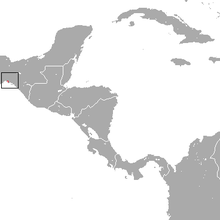Tehuantepec jackrabbit
| Tehuantepec Jackrabbit | |
|---|---|
| Scientific classification | |
| Kingdom: | Animalia |
| Phylum: | Chordata |
| Class: | Mammalia |
| Order: | Lagomorpha |
| Family: | Leporidae |
| Genus: | Lepus |
| Species: | L. flavigularis |
| Binomial name | |
|
Lepus flavigularis Wagner, 1844 |
|
 |
|
| Tehuantepec Jackrabbit range | |
The Tehuantepec jackrabbit (Lepus flavigularis) is easily distinguished from other species of jackrabbits by two black stripes that run from the base of the ears to the nape, and by its white flanks. Underparts are white, upperparts are bright-brown washed with black, rump is gray, and the tail is black. This leporid is one of the largest jackrabbits and has large ears and legs. Adults weigh about 3500 to 4000 grams.
The Tehuantepec jackrabbit is a rare endemic of Oaxaca, México, and is only found along savannas and grassy dunes on the shores of a salt water lagoon connected to the Gulf of Tehuantepec. Three small populations persist isolated from each other.
The former distribution of the Tehuantepec jackrabbit is not documented in detail, but it is estimated that the leporid's historic geographic range along the Mexican Pacific Coast on the Isthmus of Tehuantepec from Salina Cruz in Oaxaca to Tonalá in Chiapas, an area of perhaps only 5000 km sq.
Tropical dry savannas dominated by native grasses (Bouteloua, Paspalum) with an overstory of sparse bushes of nanche (Byrsonima crassifolia), and scattered trees of morro (Crescentia) are selected by the Tehuantepec jackrabbit. The Tehuantepec Jackrabbit is also found in coastal grassy dunes with Opuntia decumbens, Opuntia tehuantepecana, and Sabal mexicana.
Home ranges overlap with one or more individuals regardless of sex and age, and home range size is about 50 ha with core areas of 9 ha for adult jackrabbits. The Tehuantepec jackrabbit is nocturnal and crepuscular, and during the diurnal hours it rests in forms under bushes or grasses.
Native mammals that coexist with the Tehuantepec jackrabbit are the eastern cottontail (Sylvilagus floridanus), the nine-banded armadillo (Dasypus novemcinctus), the hooded and western hog-nosed skunks (Mephitis macroura, Conepatus mesoleucus), the Virginia opossum (Didelphis marsupialis), the gray mouse opossum (Tlacuatzin canescens), the gray fox (Urocyon cinereoargenteus), the common raccoon (Procyon lotor), and the coyote (Canis latrans). Of these, the gray fox and the coyote are native predators of the Tehuantepec jackrabbit.
...
Wikipedia

